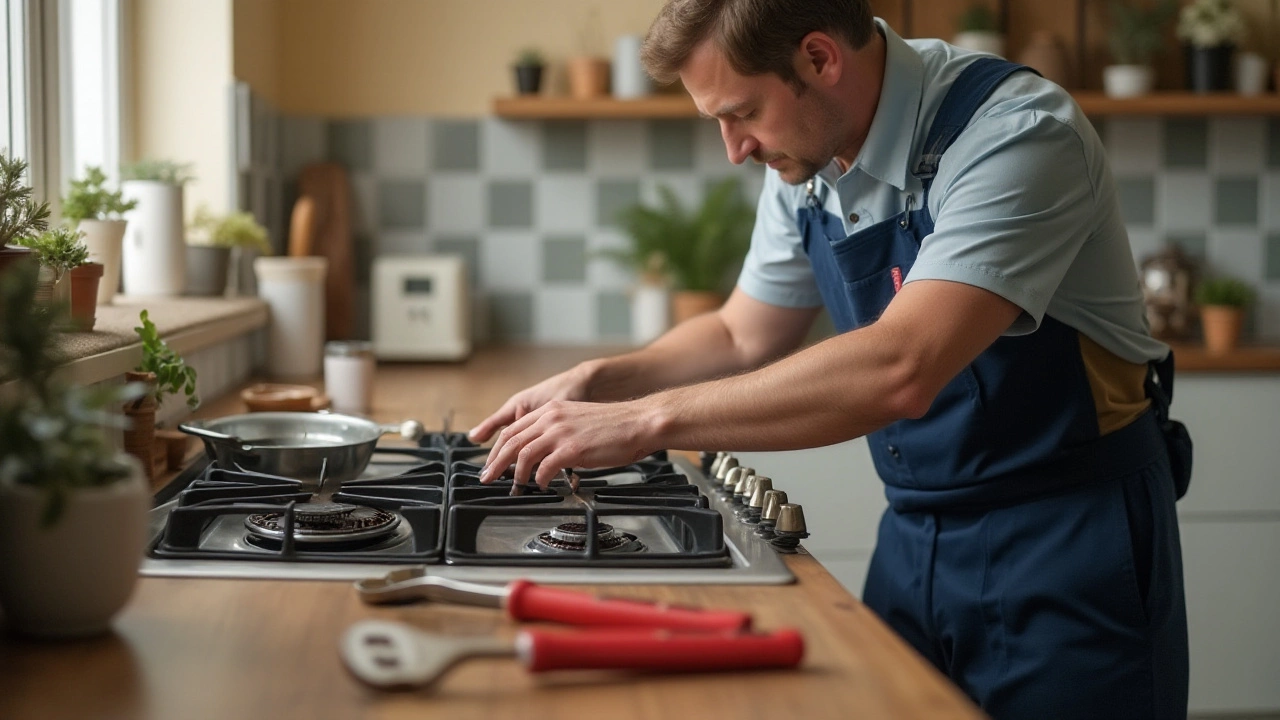A kitchen hob might not steal the spotlight like a sleek oven or a charming refrigerator, yet it’s undeniably the unsung hero of many a delicious meal. This hardy appliance must endure intense heat, frequent spills, and the rhythmic dance of your culinary experiments. But what happens when this trusty kitchen companion starts showing signs of distress? Understanding the basics of hob maintenance and repair can spare you from kitchen catastrophes.
Every hob has its own unique set of parts, and each one depends on a delicate balance to function smoothly. This article will guide you through the life of a hob, exploring common issues that arise, and unravel the mysteries of minor repairs you can handle at home. Armed with this knowledge, you'll gain not only appreciation for this kitchen essential but also the empowerment to tackle minor mishaps before they disrupt your cooking plans. So, roll up your sleeves, and let’s dive into the world of hob care.
- The Anatomy of a Kitchen Hob
- Common Hob Problems
- Routine Maintenance Tips
- DIY Hob Troubleshooting
- Choosing Professional Repair Services
- Extending the Life of Your Hob
The Anatomy of a Kitchen Hob
When you glance at a kitchen hob, it might seem like a simple flat surface with a few burners, but there’s much more beneath the exterior than meets the eye. Let's dive deep into what makes up this vital cooking appliance. Starting with the burners, the heart of any hob—they are engineered to withstand high heat and distribute flames evenly for cooking perfection. Nowadays, most hobs come in various types: gas, electric, induction, and ceramic. Each type offers unique features and requires specific care. The intuitive precision of a gas hob allows for instant heat adjustment, while the smooth surface of electric hobs makes them a breeze to clean.
The ignition system is another crucial component that should not be overlooked. Automatic ignition is common in modern gas hobs, where a simple twist of the knob sparks a flame. An intricate maze of controls lies beneath, connecting the knob to the electric igniter. Induction hobs, meanwhile, take advantage of advanced electromagnetic technology. This tech savvy option not only heats pans with impressive speed but also keeps the hob surface cool, reducing burn risks. As an added safety measure, most hobs now feature built-in thermocouples—devices that cut off the gas supply if the flame is extinguished, preventing gas leaks and potential hazards.
Below the surface, a well-designed hob hides an array of sensors and circuitry. These electronics are responsible for regulating power levels and managing various indicators like residual heat warnings. For electric hobs, the heating elements play a pivotal role, converting electrical energy into heat through resistance. In induction models, coils create a magnetic field that generates heat directly in the pot or pan placed on it. This intricate interplay of components and technologies makes the kitchen hob not only a marvel of engineering but also a necessity in culinary endeavors.
"The kitchen is the heart of every home, for the most part. It evokes memories of your family history." - Debi Mazar
In terms of safety features, many modern hobs include automatic shut-off functions and child lock capabilities, speaking to their evolution from simple cooking aids to smart appliances. Understanding these elements can greatly enhance the way in which you interact with your hob on a daily basis. Simply cleaning the ignition system periodically can prevent common issues, while knowing how to interpret the signals from your hob's sensors can assist in identifying problems before they escalate.
Lastly, the array of materials used for the hob's surface not only serves aesthetic purposes but also practical ones. Stainless steel is a classic choice for its resilience and ease of cleaning. Glass-ceramic tops provide heat resistance and a sleek design, but they necessitate careful handling to avoid scratches. By appreciating these individual components and their functions, homeowners can cultivate a more harmonious kitchen environment, ensuring that their cooking appliance serves them for many meals to come.
Common Hob Problems
The kitchen hob, much like any trusty appliance, can face an array of issues that might disrupt your seamless cooking routine. One of the frequent culprits is the igniter malfunction. Imagine standing over your hob, poised to brew pasta to perfection, only to find the gas flowing but no flame in sight. This problem often stems from food residues that linger or a gap in the electrical circuit. Cleaning the igniter gently with a toothbrush can sometimes restore it, but persistent issues might indicate the need for a replacement part.
Another notorious problem lurking beneath the gleaming surface of your kitchen hob is uneven heating. This issue usually raises eyebrows when your vegetables are flambéed while the meat remains half-cooked. Quite a conundrum! This anomaly can be traced back to damaged burners or clogs stemming from spillovers. To address this, a thorough cleaning of the burner components is often the remedy. Be sure to use a soft brush to clear the debris. A misaligned hob can also be the snag; adjusting it can restore even distribution of heat.
Gas leaks, the specter that haunts many a homeowner's dreams, is another concern. Unnerving as it sounds, it is crucial to remember that regular maintenance can thwart this potential hazard. A family in Phoenix once found this out the hard way but were grateful the problem was caught in time through regular servicing. A gas leak often manifests as an unpleasant odor, prompting immediate attention. If you hear a hissing sound when the hob is off, it's best to contact a professional to assess the situation.
A stitch in time saves nine is a piece of wisdom one can't ignore when dealing with gas leaks. As cooking appliance experts from Appliance World advise, 'Regular checks and swift response to common hob problems can prevent costly repairs and ensure safety.'
Misfiring elements within electric hobs also pose a challenge. This is often caused by a malfunction in the device's circuit, sometimes linked to a power surge. If a specific element isn't heating up, swapping it with another that functions correctly might help isolate the faulty component. It's a fiddly task, but feasible with a bit of patience and care. Deep within the underbellies of urban kitchens, homeowners face these inconveniences and find themselves navigating the maze of appliance repairs.
Finally, there's the inevitable issue of hobs simply not turning on. This situation can often be remedied by checking the connection first. Seems too simple, but you'd be surprised at how many times the plug is the problem. If connecting the hob proves fruitless, inspecting for blown fuses is the next step. Sometimes the fix can be as simple as replacing a fuse, ushering in the warmth of a functioning hob. Staring at a lifeless hob can feel daunting, but many have triumphed over this setback by understanding the inner workings of their appliances.
These are merely a few of the myriad issues that can arise. Each incident holds the potential to temporarily unsettle your culinary adventures, yet armed with knowledge and a bit of care, these stumbling blocks can be transformed into stepping stones, paving the way to masterful meal creations. Keeping your cooking appliance in good nick involves both proactive maintenance and a swift response to problems as they make their appearances.

Routine Maintenance Tips
Keeping your kitchen hob in prime condition involves more than just a wipe down after a spaghetti sauce mishap. Routine maintenance is crucial not only for extending the appliance’s lifespan but also for ensuring safe and efficient cooking experiences. One of the most basic yet essential steps is to regularly clean the hob’s surface after each use. This helps to prevent the buildup of grease and grime that can eventually clog burners or nozzles, leading to uneven heating and potential gas leaks. To ensure a thorough clean, remove all detachable parts and soak them in warm, soapy water. A non-abrasive scrubber can be your best friend here, tackling stubborn stains without scratching the surface.
Apart from cleaning, it is imperative to check the burners and ignition systems. Even minimal food residues or moisture can lead to faulty ignition, so take the time to clean these components regularly. For gas hobs, inspect the burner caps and bases frequently for signs of rust or damage. If you notice any deterioration, replacing these parts immediately can prevent inefficient gas flow. Electric hobs should have their coils or induction surfaces examined for consistent heating. A few minutes spent here can save hours of frustration in the kitchen.
In terms of safety, every homeowner should conduct regular checks on the gas connections if they own a gas hob. Using a mixture of water and soap, lather up the hose and fittings, then observe any bubbles forming. This simple test can reveal leaks in the system, which, when left unchecked, could lead to hazardous situations. Listen for unusual sounds too. If you hear any hissing, it might be a sign of a problem requiring professional intervention.
It's recommended to incorporate an annual or bi-annual professional inspection into your routine maintenance schedule. According to an article in
The Appliance Repair Journal, ‘For any gas-operated kitchen appliance, it is advisable to allow a certified technician to perform a detailed inspection at least once a year.’This ensures that elements beyond your regular checks, such as internal wirings and gas regulators, are in good shape, mitigating risks of unexpected breakdowns.
In case you prefer to track your maintenance efforts, consider using a log or journal. Documenting the cleaning, parts replaced, and inspections done will provide a useful reference down the road. Look for patterns or recurrent issues and address them promptly. This proactive approach highlights not only good maintenance practices but also preparedness, giving you peace of mind knowing your trusted hob repair methods and care are well-tracked and consistent.
DIY Hob Troubleshooting
Even the most reliable kitchen hob can encounter issues from time to time, and knowing how to manage these hiccups can save you both time and money. Let's start with one of the most common problems: ignition issues. If your hob doesn’t ignite, the first thing to check is whether the hob is properly connected to a power source and the gas supply is on for gas hobs. Sometimes, food or grease can block the igniter. To address this, ensure that both the igniter and surrounding areas are clean. Use a soft brush or cloth to carefully scrub away any debris. Always ensure you’re working in a safe environment and the hob is off before cleaning!
Another issue is uneven cooking, often caused by clogged burners. Uneven heat distribution can make cooking a hassle, but it’s often easily remedied. Remove the burner heads and rinse them under warm water, scrubbing lightly with a small brush to remove residue. If this doesn’t solve the problem, check to see if the gas ports are aligned correctly. Misaligned ports can limit gas flow, leading to uneven cooking. Remember, attention to small details like this can make a big difference in your cooking experience.
Sometimes, a hob might produce a clicking sound even when it's not in use. This could be due to moisture in the spark module caused by spills or cleaning. In this case, it's crucial to dry the spark module completely; a hairdryer set on a low setting can be useful here. Another possible solution is ensuring the knobs are in the off position, as partially turned knobs might trigger the ignition system, leading to the persistent clicking noise.
Hob repair doesn’t just stop at fixing; it involves diagnosing problems correctly. If you experience gas odors around your cooking appliance, it might indicate a gas leak, which requires immediate professional attention. Never attempt to repair gas leaks yourself due to the hazardous nature of gas. To prevent leaks, routinely check the regulator and hose connections to your hob, ensuring they are tight and not worn out. For electric hobs, if the unit is completely unresponsive, it might be an issue with the internal fuse. In such cases, consult a professional for an accurate diagnosis and repair.
Finally, understanding the basic troubleshooting steps can significantly extend the lifespan of your kitchen hob. Manufacturers suggest regular maintenance checks, including cleaning burner parts and inspecting igniters. As per appliance experts, these simple tasks can prevent most common issues. One expert once said,
“Regularly cleaning and inspecting your cooking appliances not only ensures safety but also enhances their longevity and performance.”This piece of advice is invaluable as it highlights the importance of consistent care.
By familiarizing yourself with these straightforward troubleshooting techniques, you’ll find that most minor hob repair tasks become manageable. You're not only saving on repair costs but also getting more acquainted with one of the most essential kitchen appliances. Knowledge is power, and when it comes to maintaining your kitchen equipment, having the right tips and tricks at your fingertips can make all the difference.

Choosing Professional Repair Services
Deciding on a professional repair service for your precious kitchen hob can sometimes seem daunting, given the myriad of options available. To start with, a key factor in selecting the right service involves examining the technicians’ qualifications and experience. Most reputable companies offer detailed information about their technicians' training and years of experience. Experienced technicians are more likely to recognize and efficiently solve your hob repair issues without unnecessary trial and error. This not only saves you time but also often reduces the cost because they get it right the first time.
When evaluating repair services, it is also beneficial to consider customer reviews and testimonials. Platforms like Google Reviews, local forums, or Yelp can provide a wealth of information from people who have utilized these services. This community feedback can help gauge a company’s reputation and reliability. It’s worth noting that while no service may boast a perfect five-star rating, the way a company handles negative feedback often speaks volumes about their customer service philosophy. Here’s a little-known fact: companies that actively respond to and resolve customer complaints tend to have substantially higher client retention and satisfaction rates.
In addition, checking whether the repair service provides guarantees or warranties is crucial. A confident company backs its repairs with a warranty, ensuring that if the same problem recurs within a specified timeframe, they will fix it at no extra charge. This assurance protects you and gives peace of mind, knowing you won’t be on the hook for recurring issues. It is advisable to inquire directly about warranty terms and guarantee policies before committing to a service provider. According to a Consumer Reports article from 2022, customers who hired repair services offering extended warranties reported 25% higher satisfaction and fewer repeat repairs.
Pricing transparency is another essential factor. Legitimate businesses provide an upfront, detailed breakdown of costs, including labor, parts, and any additional service fees. Being wary of unusually low estimates is wise, as they can sometimes lead to surprise charges once the service is completed. A practical approach could be obtaining quotes from multiple services to compare and contrast what you are being offered. Here is a useful tip: ask the service if they charge for diagnostic assessments separately and whether this fee is taken off the final repair bill if you proceed with their services.
Finally, checking for additional customer support services can tip the scale in favor of one provider over another. Companies offering 24/7 customer helplines or online chat support increase accessibility and can provide extra assistance in allaying your concerns outside regular business hours. This level of service suggests a customer-focused approach and the importance a company places on building long-term client relationships. A study by the Service Council in 2023 found that 67% of customers rated after-sales support as a key factor in their decision-making process.
Extending the Life of Your Hob
Keeping your kitchen hob in pristine condition is not only about maintaining its aesthetic appeal but also about ensuring its constant functionality and longevity. A well-maintained hob is key to efficient cooking, saving you both time and energy. One of the most effective ways to prolong your hob's life is by cleaning it routinely. Residue from spills and splatters on the burner can obstruct proper functioning if left unattended. Using gentle cleaning products specifically designed for cooking appliances, you can gently scrub the burners and surface, making sure all cooking debris is removed. This prevents accumulation that can lead to corrosion or clogging.
Did you know that over 60% of hob malfunctions arise from improper cleaning practices? Installing a regular cleaning schedule, such as wiping down the hob after each cooking session, can drastically cut down on the grime buildup. A simple soap-water solution and a soft cloth can do wonders. Once a month, take the time to dismantle removable components and soak them for deep cleaning. It's advised to avoid abrasive scrubbers that could scratch or damage the surface. Paying attention to these little details significantly extends the life of your beloved cooking appliance.
Another critical factor in extending your hob’s lifespan is ensuring it receives regular maintenance check-ups by a professional, particularly in the case of gas hobs. Entrust your appliance to a certified technician who can calibrate and assess gas fittings for any leaks or adjustments needed. “Routine check-ups increase appliance efficiency by nearly 40%,” states a report by the National Kitchen Appliance Examiner. By scheduling annual inspections, you can identify and rectify minor issues before they escalate into costly repairs.
Avoiding overuse and being mindful of the appliance’s limitations helps too. Each kitchen hob has a designated capacity which, if exceeded, can strain its components and reduce operational efficiency. Instead of crowding pots and pans in a bid to hasten cooking, opt for a staged cooking process. Depending on your hob’s make and model, working within the manufacturer’s guidelines for optimal use ensures that the appliance serves you well for years.
Lastly, implementing small changes in how you use your hob can yield significant benefits. For instance, using cookware with flat, smooth bottoms ensures optimal heat distribution, which saves energy. Furthermore, ensuring the pots and pans cover the entirety of the burner’s flame prevents heat wastage, preserving the burner’s efficiency. Consider using lids on pots to trap heat, which allows you to cook at lower settings and prolong the lifespan of burners. If you're considering an upgrade, induction hobs are known for their longevity since they reduce physical wear caused by cooking heat cycles.
When investing in a cooking appliance, consider one with a solid warranty or a reputable service network, ensuring that, in case of a malfunction, expert assistance is readily available. This little research before purchase can set you up for smooth, long-standing service from your kitchen hob. The life of a hob can be rich and full of flavor if tended with care, knowledge, and a little dose of routine. By adopting these practices, you’re ensuring that your trusted appliance continues to serve up hearty meals and memories for many more years to come.


